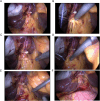Laparoscopic primary suture of the common bile duct in patients with common bile duct stones: a comparative analysis of two suturing methods in terms of safety, efficacy, and convenience with 16-month follow-up
- PMID: 40217515
- PMCID: PMC11992877
- DOI: 10.1186/s12893-025-02904-x
Laparoscopic primary suture of the common bile duct in patients with common bile duct stones: a comparative analysis of two suturing methods in terms of safety, efficacy, and convenience with 16-month follow-up
Abstract
Background: Primary suturing of the common bile duct (CBD) is increasingly used in laparoscopic common bile duct exploration (LCBDE) for selected patients, though the optimal suturing method remains unclear. This study compares the efficacy of continuous versus interrupted sutures for primary CBD closure in patients with CBD stones.
Methods: A retrospective analysis was conducted on 120 patients with CBD stones who underwent primary CBD closure at Yancheng First People's Hospital from October 2022 to December 2023. Data included demographics, hospital stay, complications, and follow-up outcomes. Of these, 69 received continuous sutures, and 51 received interrupted sutures.
Results: No significant differences were found in age, gender, body mass index (BMI), CBD diameter, preoperative bilirubin levels, or stone residuals between groups. The incidence of postoperative fever, bile leakage, electrolyte disturbances, bleeding, wound infection, and CBD stricture was similar. Continuous suturing required less operative time than interrupted suturing (p < 0.01).
Conclusion: Both continuous and interrupted suturing techniques are safe and effective for CBD closure in selected patients, though continuous suturing is more time-efficient.
Keywords: Common bile duct stones; Continuous suturing; Interrupted suturing; Minimally invasive surgery; Primary closure of the common bile duct; Retrospective study.
© 2025. The Author(s).
Conflict of interest statement
Declarations. Ethics approval and consent to participate: This retrospective study was carried out in compliance with the ethical guidelines of the institutional and national research committee, as well as the 1964 Helsinki Declaration and its subsequent amendments or equivalent ethical standards. The Institutional Review Board of Yancheng First Hospital waived the requirement for ethical approval due to the study’s non-invasive nature and the use of de-identified patient data. Consent for publication: Not applicable. Competing interests: The authors declare no competing interests.
Figures


Similar articles
-
Primary suture for patients of bile duct stones after laparoscopic biliary tract exploration: a retrospective cohort study.Updates Surg. 2023 Jun;75(4):897-903. doi: 10.1007/s13304-023-01451-5. Epub 2023 Feb 7. Updates Surg. 2023. PMID: 36749505
-
Comparison on the Efficacy of Three Duct Closure Methods after Laparoscopic Common Bile Duct Exploration for Choledocholithiasis.Med Sci Monit. 2019 Dec 20;25:9770-9775. doi: 10.12659/MSM.918743. Med Sci Monit. 2019. PMID: 31857570 Free PMC article.
-
Appropriate Patient Selection Is Essential for the Success of Primary Closure After Laparoscopic Common Bile Duct Exploration.Dig Dis Sci. 2017 May;62(5):1321-1326. doi: 10.1007/s10620-017-4507-0. Epub 2017 Mar 1. Dig Dis Sci. 2017. PMID: 28251501
-
Laparoscopic common bile duct exploration plus cholecystectomy versus endoscopic retrograde cholangiopancreatography plus laparoscopic cholecystectomy for cholecystocholedocholithiasis: a meta-analysis.Surg Endosc. 2019 Oct;33(10):3275-3286. doi: 10.1007/s00464-018-06613-w. Epub 2018 Dec 3. Surg Endosc. 2019. PMID: 30511313 Review.
-
Mini-Invasive management of concomitant gallstones and common bile duct stones : where is the evidence ( Review article).Tunis Med. 2019 Aug-Sep;97(8-9):997-1004. Tunis Med. 2019. PMID: 32173848
References
-
- Warner RL, Coleman KC, Musgrove KA, Bardes JM, Borgstrom DC, Grabo DJ. A review of general surgery resident experience in common bile duct exploration in the ERCP era. Am J Surg. 2020;220(4):899–904. - PubMed
-
- EASL Clinical Practice Guidelines on the prevention. diagnosis and treatment of gallstones. J Hepatol. 2016;65(1):146–81. - PubMed
-
- McDermott J, Kao LS, Keeley JA, Nahmias J, de Virgilio C. Management of Gallstone Pancreatitis: A Review. JAMA Surg. 2024;159(7):818–25. - PubMed
-
- Williams E, Beckingham I, El Sayed G, Gurusamy K, Sturgess R, Webster G, Young T. Updated guideline on the management of common bile duct stones (CBDS). Gut. 2017;66(5):765–82. - PubMed
Publication types
MeSH terms
Grants and funding
LinkOut - more resources
Full Text Sources

